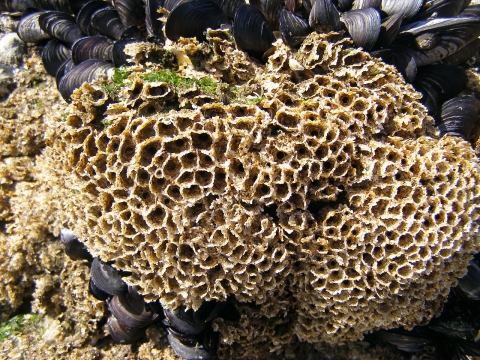
Dans le cadre du séminaire de l'ISYEB (Institut de Systématique, Evolution, Biodiversité - UMR 7205), Larisse Faroni Perez, de l'Universidade Federal de Santa Catarina (Brésil), en accueil pendant 1 an dans l'UMR BOREA, à la Station Marine de Concarneau, parlera de :
"On the distribution of Sabellariidae : inference from functional morphology"
Mardi 18 octobre de 12h30 à 13h30 à l’amphithéâtre Rouelle (Bâtiment de la baleine, situé derrière l’enclos des wallabies), MNHN, Paris
Résumé :
Sabellariidae is a highly specialized group of marine annelids and occurs from deep to intertidal seas. They live in characteristic tubes of cemented mineral particles, and sometimes attached to one another forming large reefs that can extend over several kilometers. Although sabellariids have been considered by several studies, some morphological traits and behaviours are poorly understood. For instance, recent advances have demonstrated sensorial organs and their relationship with settlement sociability (i.e. gregarious or solitary) and bathymetric ranges. Moreover, the shape of the operculum has a phylogenetic signal. However, no study has evaluated how the traits of operculum relate to adaptive radiations across bathymetric habitats. Here, the aims were 1) to understand if different opercular forms and paleae would promote differences in their effectiveness for tube sealing, and if such morphological variability can be useful for understanding evolutionary radiation into intertidal habitats ; and 2) to report new morphological traits and behaviour in Sabellaria alveolata. Analysis of specimens from collection hosted in MNHN-Paris and literature review of sabellariids was used to create a dataframe of their distribution and opercular traits. Afterward, the opercular traits and tube sealing behaviour of two intertidal species with different opercular shapes (Phragmatopoma caudata and S. alveolata) were investigated. These traits were assessed using light microscopy, SEM, and observations of live organisms. Results indicated that number of rows of paleae, their shape and orientation are the foremost divergence among sabellariids from intertidal and deep seas, and it could function as a key morphological feature for living between tides. P. caudata have entire opercular crown, double layer of paleae that close tube opening, likely to minimize desiccation process during low tide. S. alveolata close their tube openings with sediment at low tide, and this behaviour can minimize the environmental stress which intertidal organisms face. Finally, this species has an ability to perceive movements, and potential photoreceptors features are described.
